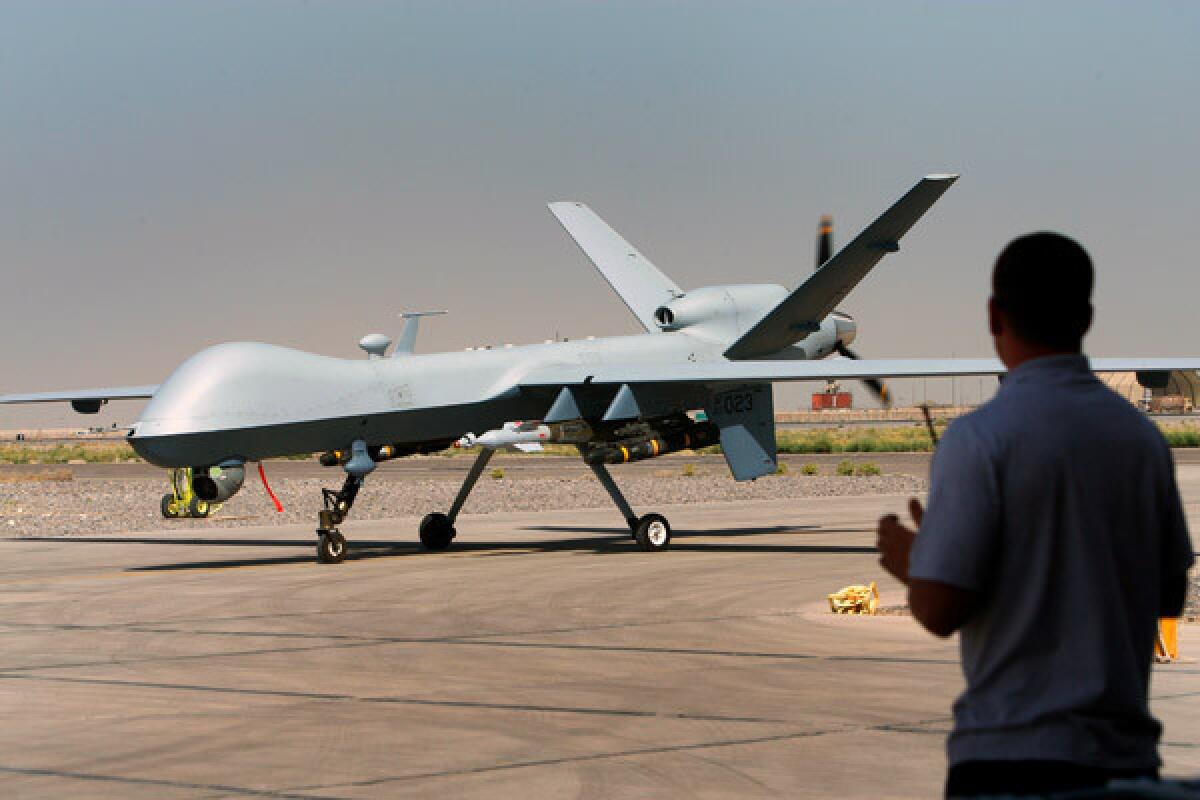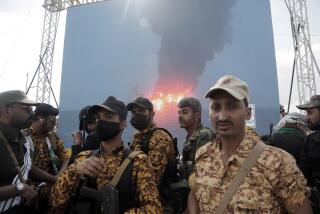War zone drone crashes add up

- Share via
Reporting from Kandahar, Afghanistan — The U.S. military often portrays its drone aircraft as high-tech marvels that can be operated seamlessly from thousands of miles away. But Pentagon accident reports reveal that the pilotless aircraft suffer from frequent system failures, computer glitches and human error.
Design and system problems were never fully addressed in the haste to push the fragile plane into combat over Afghanistan shortly after the Sept. 11 attacks more than eight years ago. Air Force investigators continue to cite pilot mistakes, coordination snafus, software failures, outdated technology and inadequate flight manuals.
FOR THE RECORD:
Drone accidents: An article in Tuesday’s Section A about accidents among military drone aircraft identified Col. Jeff Kappenman as director of the Center of Excellence for UAS Research, Education and Training at the University of North Dakota and retired Rear Adm. Thomas J. Cassidy Jr. as president of the aircraft systems group at General Atomics Aeronautical Systems, which makes Predator and Reaper drones. Kappenman resigned from his position in May. Cassidy assumed a new role, consultant and chairman of the executive committee, at his company in mid-March. —
Thirty-eight Predator and Reaper drones have crashed during combat missions in Afghanistan and Iraq, and nine more during training on bases in the U.S. — with each crash costing between $3.7 million and $5 million. Altogether, the Air Force says there have been 79 drone accidents costing at least $1 million each.
Accident rates are dropping, but the raw numbers of mishaps are increasing as use of the aircraft skyrockets, according to Air Force safety experts.
But no lives are lost, and for some experts that’s the most important point: For them, drones are the vanguard of a new type of remote warfare that minimizes the risk to U.S. personnel. The number of crashes, however, illustrates how quickly the unmanned aircraft have become an essential part of U.S. combat operations. At least 38 drones are in flight over Afghanistan and Iraq at any given time.
Flight hours over Afghanistan and Iraq more than tripled between 2006 and 2009. However, ground commanders in Afghanistan say only about a third of their requests for drone missions are met because of shortages of aircraft and pilots. The loss of aircraft to crashes and other accidents can hamper combat operations — and risk the lives of troops who depend on them for reconnaissance and air cover.
The Air Force acknowledges that armed drones were not ready when first deployed as the U.S. military geared up for the campaign to oust the Taliban and Al Qaeda from Afghanistan. Most weapons systems are tested and refined for years. Unarmed drones had been in use since the mid-1990s, but the first armed version went to war just nine months after it was retrofitted.
It was pushed into use after a Predator successfully launched Hellfire antitank missiles at the Naval Air Weapons testing range at China Lake in January 2001.
“It was never designed to go to war when it did,” said Lt. Col. Travis Burdine, a manager for the Air Force Unmanned Aircraft Systems Task Force. “We didn’t have the luxury of ironing out some of the problems.”
Technicians bought off-the-shelf equipment at Radio Shack and Best Buy to build a system to allow ground forces to see the drones’ video feeds. At least one drone crashed because it had no fuel gauge, and the aircraft ran out of fuel. In another crash, investigators cited a design flaw: The “kill engine” switch was located next to the switch to lower the landing gear, and a ground-based pilot confused the two.
Even now, the planes are not designed for the amount of use they’re getting, their defenders say. The 27-foot Predators and 36-foot Reapers operate under conditions that put enormous stress on the light drones — and the humans who operate them.
“These airplanes are flying 20,000 hours a month, OK?” said retired Rear Adm. Thomas J. Cassidy Jr., president of the aircraft systems group at General Atomics Aeronautical Systems in San Diego, which makes Predators and Reapers.
“That’s a lot of flying,” Cassidy said. “Some get shot down. Some run into bad weather. Some, people do stupid things with them. Sometimes they just run them out of gas.”
The drones flew 185,000 hours over Afghanistan and Iraq in 2009, more than triple the number of hours flown in 2006. The Air Force expects that number to grow to 300,000 hours this year.
“The Air Force needs as many as they can get,” said Col. Jeff Kappenman, director of the Center of Excellence for UAS Research, Education and Training at the University of North Dakota. “There has been exponential growth in need and demand.”
Air Force officials say design and training improvements have lowered the Predator’s accident rate. They say lessons learned from that plane’s problems have solved some issues for the larger and more potent Reaper, in use in combat since 2007. Accident rates per 100,000 hours dropped to 7.5 for the Predator and 16.4 for the Reaper last year, according to the Air Force. The Predator rate is comparable to that of the F-16 fighter at the same stage, Air Force officers say, and just under the 8.2 rate for small, single-engine private airplanes flown in the U.S.
The crash figures do not include drones flown over Pakistan by the CIA, which does not acknowledge the covert program. But independent experts said Predators flown over Pakistan probably experience problems similar to those flown by the Air Force in Afghanistan and Iraq.
Four Air Force Predators have crashed this year, three of them in Afghanistan — on Jan. 15 in southern Afghanistan, one on takeoff Feb. 9 in eastern Afghanistan, and a third March 14 in the southern part of the country. All were total losses, the Air Force said. Another Predator crashed in California during a training exercise April 20.
In the 12 months ended Sept. 30, the Air Force reported 16 Predator and Reaper accidents. Four involved crashes during a 15-day period in September. On Sept. 13, a pilot inside a ground station in Nevada lost video and data links to a Reaper over Afghanistan. As it was about to exit Afghan airspace and crash, an F-15 pilot was ordered to shoot it down and ground troops recovered the wreckage to keep top-secret technology out of insurgents’ hands.
In another case, a drone crashed into a Sunni political headquarters in Mosul, Iraq. No injuries were reported.
In some cases, a cause is never determined and no wreckage is recovered. On May 13, 2009, a crew in Nevada lost contact with a Predator, and it was listed as “presumed crashed” somewhere in Afghanistan, according to an Air Force report.
Retired Gen. Wesley K. Clark, asked whether high drone mishap rates concerned him, replied: “Not really. They’re expendable.” Others disagree, saying every drone that goes down is one less available for troops in need.
“We can’t treat these things like disposable diapers and just throw them out,” retired Air Force Gen. Hal Hornburg, former chief of the Air Force Air Combat Command, warned officers at a conference on drones.
Kyle Snyder, who tracks military drones for the Assn. for Unmanned Vehicle Systems International, a nonprofit research group, said he had never heard anyone in the Air Force call drones expendable.
A 2007 study by the Air Force Research Laboratory found that up to 80% of Predator crashes involved some degree of human error. Updated studies attribute more recent accidents to inadequate manuals, crew coordination mistakes and crews being asked to perform tasks for which they are not fully trained, according to an analysis by the Air Force and a private contractor.
After a Predator crashed during a landing at Kandahar air base in March 2007, investigators faulted the Predator system for a “lack of visual cues” to help pilots understand the position of a plane flying half a world away. The pilot in Nevada misjudged the drone’s altitude, the investigative report said.
The Predator that ran out of fuel over Iraq had a leak, but there was no gauge to warn the pilot, an Air Force crash researcher said. And a pilot trainee at Creech Air Force Base in Nevada crashed a Predator by hitting the “kill engine” switch instead of the adjacent landing gear switch, according to an investigative report.
Some ground control stations, where pilots and camera operators sit, still have 1990s-era text-based computer systems. Pilots have to type function and control commands rather than clicking on icons.
“There’s a control delay between typing something and having it actually happen on the airplane,” said Gregg Montijo, a contractor who trains drone crews. “When the heat is on, sometimes guys will type something in, then type it again real quickly. They’ll confuse the computer and get the wrong display and get into a vicious cycle.”
Despite the mishaps, Burdine said, Predators and Reapers are doing great work. “It’s a big payoff for the Air Force to make sure the next generation of systems learns from the first generation,” he said. “And that’s what we’re doing.”
More to Read
Sign up for Essential California
The most important California stories and recommendations in your inbox every morning.
You may occasionally receive promotional content from the Los Angeles Times.











